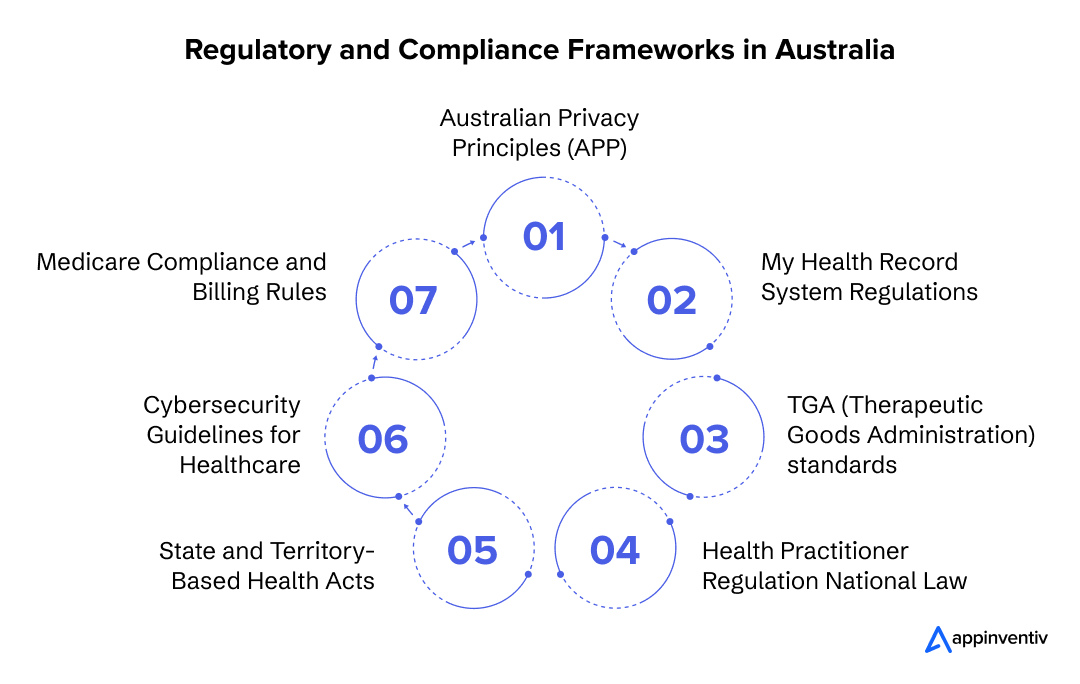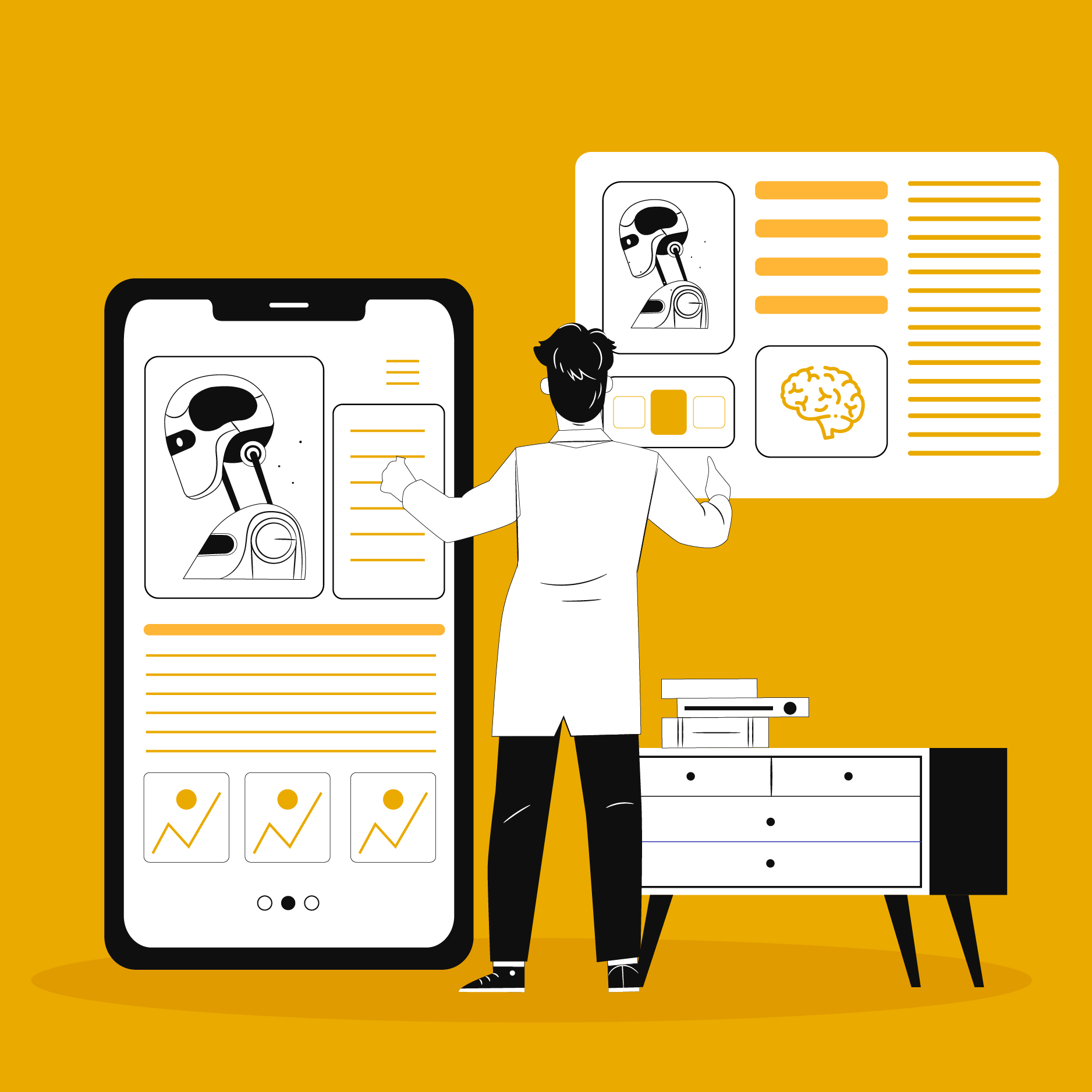- Understanding the Need for Healthcare Software
- Understanding Australia’s Regulatory Landscape
- Step-by-Step Process for Healthcare Software Development
- Cost Considerations for Healthcare Software Development
- Factors Affecting the Cost of Healthcare Software Development
- Use Cases of Healthcare Software Development in Australia
- AI-Powered Digital Assistants
- Healthcare Booking System
- Digital Health Record System
- Top Healthcare Software Development Trends to Watch in 2025
- AI-Generated Synthetic Data for Research & Training
- Edge Computing for Real-Time Health Data Processing
- Digital Twin Technology in Healthcare
- Decentralized Healthcare with Blockchain & Web3
- Tackling Key Challenges in Healthcare Software Development
- How to Choose the Right Technology Partner
- Embark on Healthcare Software Development with Appinventiv’s Support
- FAQs
This in-depth guide on healthcare software development in Australia equips CEOs with valuable insights into emerging trends, cost factors, and strategic approaches. It explores the impact of advanced technologies on development costs and scalability. Additionally, it provides an overview of key Australian use cases and the challenges associated with implementing healthcare software solutions.
Imagine a healthcare system under pressure—an aging population, skyrocketing demand for remote care, and patients with higher expectations. Yes, in Australia, the healthcare industry is at a crossroads.
With an aging population, increasing demand for remote care, and rising patient expectations, the system faces mounting pressure to deliver better outcomes efficiently. Digital transformation in healthcare is key to overcoming these challenges and providing better, more efficient outcomes.
Australia’s National Digital Health Strategy and the National Healthcare Interoperability Plan focus on creating systems that seamlessly connect and share meaningful information. This vision aims to enhance the country’s healthcare services by improving collaboration across various health sectors, enabling more efficient patient care, and ensuring data is accessible in real-time.
As a CEO, you have a unique opportunity and responsibility—to lead the charge in harnessing custom healthcare software development expertise to transform care delivery.
Healthcare software isn’t just about digitizing processes; it’s about enabling seamless patient experiences, empowering healthcare providers, and driving operational excellence. The potential is enormous, from telemedicine trends that bring care to rural communities to data analytics in healthcare that improve decision-making.
This guide is designed to equip you with the insights and strategies you need to navigate the complexities of healthcare software development in Australia. Whether you aim to enhance patient care, ensure regulatory compliance, or future-proof your organization, this roadmap will help you make informed decisions at every step of the journey.
Understanding the Need for Healthcare Software
Healthcare software transforms the healthcare ecosystem by creating a seamless, connected experience for patients, providers, and administrators. For patients, it ensures faster access to care through telemedicine, real-time health monitoring, and personalized treatment plans, encouraging them to take charge of their health.

Providers benefit from advanced tools like AI-driven medical diagnostics, streamlined workflows, and enhanced collaboration, which enable them to focus more on improving patient care and lessen administrative burdens.
Administrators gain the ability to optimize operations, ensure compliance, and reduce errors with automated billing and scheduling systems. By bridging gaps and enhancing efficiency, healthcare software delivers value to all stakeholders, driving better outcomes and experiences.
To better understand this, let’s examine a few popular types of software used in the healthcare industry.
- Telemedicine Platforms: These platforms enable remote consultations and virtual care through secured messaging and video calls, thus closing the divide between patients and healthcare providers.
- Electronic Health Records (EHR): EHR systems are digital platforms that store, manage, and share patient health information securely, improving provider coordination and ensuring quick access to critical data.
- Healthcare Data Analytics: Healthcare analytics software development in Australia leverages AI and big data in healthcare to analyze patient trends, optimize resource allocation, and improve decision-making across healthcare organizations.
- Remote Patient Monitoring (RPM): RPM software utilizes wearable devices and IoT sensors to track patients’ vital signs in real-time, ensuring proactive care for chronic conditions.
- Practice Management Systems: The practice management system integrates scheduling, billing, and administrative functions into one platform, streamlining clinical operations and reducing paperwork.
- Clinical Decision Support Systems (CDSS): The CDSS provides evidence-based recommendations to assist healthcare providers in making informed treatment decisions.
- Medical Imaging Software: This software processes and analyzes imaging data like X-rays, MRIs, and CT scans, aiding in precise diagnosis and treatment planning.
- Healthcare CRM Software: Healthcare CRM software development in Australia enables providers to create tailored CRM systems that foster stronger patient relationships. These systems support personalized care and enhance patient engagement by tracking appointments, communications, and feedback.
- Healthcare Scheduling Software: Healthcare scheduling software development in Australia simplifies appointment booking and ensures seamless clinic operations by eliminating scheduling conflicts and optimizing resource allocation.
- ERP Healthcare software: ERP software healthcare development in Australia integrates various hospital and clinic functions, including patient management, billing, and inventory tracking, into a unified system, improving operational efficiency, reducing costs, and enhancing overall service delivery.
Understanding Australia’s Regulatory Landscape
Compliance is vital in keeping patient data safe and secure and building trust. Let’s look at some of the top healthcare compliances in Australia that healthcare organizations must comply with to protect patient information and deliver quality care.

- Australian Privacy Principles (APP): Established under the Privacy Act 1988, the APPs outline strict protocols for managing personal health information. These principles emphasize obtaining patient consent, safeguarding data, and limiting access to authorized personnel.
- My Health Record System Regulations: These regulations, governed by the My Health Records Act 2012, oversee the national electronic health record system, ensuring data security and privacy while facilitating authorized access for better care coordination.
- TGA (Therapeutic Goods Administration) standards: The TGA regulates medical devices such as Software as a Medical Device (SaMD), ensuring they meet stringent safety, quality, and performance criteria.
- Health Practitioner Regulation National Law: Establishes professional and ethical standards for healthcare practitioners, ensuring they adopt healthcare software responsibly while prioritizing patient care quality.
[Also Read: How Much Does It Cost to Build a Healthcare Practice Management Software like Cliniko?]
- State and Territory-Based Health Acts: Supports federal regulations by addressing region-specific healthcare needs, such as mandatory reporting requirements or operational standards tailored to local challenges.
- Cybersecurity Guidelines for Healthcare: Published by the Australian Digital Health Agency (ADHA), these guidelines assist healthcare organizations in safeguarding sensitive data against cyber threats. They focus on secure access controls, data encryption, and routine system audits.
- Medicare Compliance and Billing Rules: Designed to promote ethical and transparent billing practices within the Medicare system, these rules require healthcare software to ensure accurate claims processing, minimize errors, and prevent fraud.
Also Read: Appinventiv for Healthcare Software Development Services
Step-by-Step Process for Healthcare Software Development
Australia’s healthcare software development process outlines the essential stages of creating, deploying, and maintaining robust and secure healthcare applications. From analyzing project requirements and design to development, testing, and post-launch support, each phase ensures compliance, functionality, and scalability to meet industry standards and patient needs. This flowchart provides a clear, step-by-step overview of the process.

Step 1 – Start with Your Goals: Ensure the software aligns with your organization’s mission. Whether improving patient care, simplifying operations or boosting efficiency, your goals should guide every step of the development process.
Step 2 – Plan the Roadmap: Plan the big picture with clear milestones, realistic timelines, and a solid budget. Break the process into manageable steps to keep everything on track.
Step 3 – Choose the Right Technology: Choose tools and platforms that match your goals and ensure scalability, security, and compliance. To future-proof your software, consider cutting-edge technologies like AI, IoT, or cloud solutions.
Step 4 – Focus on Usability: Design the software with usability in mind, making it easy for everyone, including people with disabilities. An intuitive interface makes a big difference in adoption and satisfaction.
Step 5 – Develop in Steps and Test Often: Use an iterative approach like agile to build the software in smaller chunks. Test each phase thoroughly to fix bugs and make improvements along the way.
Step 6 – Plan for Seamless Integration: Ensure your software works smoothly with existing systems like EHRs or billing platforms. It should also be designed to handle future growth and new features.
Step 7 – Keep Improving: Once the software is live, monitor its performance and gather feedback. Regular updates and tweaks will keep it relevant and efficient as needs evolve.
Cost Considerations for Healthcare Software Development
The cost of healthcare software development in Australia ranges from AUD 40,000 to AUD 500,000, depending on various factors. Let’s examine those.

Factors Affecting the Cost of Healthcare Software Development
Integration Requirements
Connecting the software to existing systems such as hospital management platforms, IoT devices, or wearables adds complexity. Tailored API development and seamless interoperability solutions increase development time and overall costs of healthcare software development Australia.
Technology Stack
Opting for advanced technologies like AI, blockchain, or cloud-based infrastructure can increase the initial costs of healthcare software development in Australia. However, these modern healthcare software solutions often deliver better scalability, enhanced performance, and lower long-term maintenance expenses.
Features
Including functionalities like telehealth modules, patient portals, AI-powered diagnostics, and EHR integration significantly impacts costs. Complex features of healthcare software development in Australia require additional development time, advanced tools, and skilled professionals.
Businesses can partner with a dedicated firm like Appinventiv Australia to integrate advanced features in their applications, ensuring a blend of innovation, efficiency, and compliance tailored to meet industry standards and improve patient care.
Complexity
Incorporating advanced functionalities such as secure multi-platform interoperability, real-time data sharing, or predictive analytics involves intricate system architecture. This necessitates the involvement of specialized developers and rigorous quality assurance processes.
Timelines
Accelerated project deadlines demand more resources, including larger development teams or overtime work. This often leads to higher expenses of healthcare software development Australia due to expedited resource allocation and increased workforce involvement.
Use Cases of Healthcare Software Development in Australia
Various impactful use cases are shaping healthcare software development Australia. Let’s explore some top examples that highlight the innovative ways healthcare providers are leveraging technology:
AI-Powered Digital Assistants
AI-powered digital assistants are revolutionizing healthcare by automating patient interactions, optimizing administrative workflows, and improving customer support. These intelligent systems lighten the burden on healthcare professionals, accelerate response times, and enhance data accuracy, ultimately driving cost savings and operational efficiency.
Real-Life Example: NIB’s AI-Powered Digital Assistant
NIB, a leading Australian health insurer, introduced ‘Nibby’, an AI-powered digital assistant, to enhance customer interactions and streamline operations. By automating routine inquiries and reducing call volumes, Nibby has decreased human customer service demand by 60% and cut phone calls with agents by 15%. This AI-driven approach has led to $22 million in operational savings while improving efficiency and customer satisfaction.
| Aspect | Details |
|---|---|
| Use Case |
|
| Results |
|
Healthcare Booking System
A healthcare booking system enhances the patient experience by providing a seamless platform for scheduling appointments with healthcare providers. It reduces wait times, improves accessibility, and streamlines administrative workflows, making healthcare services more efficient and patient-centric.
Real-Life Example: HealthEngine
HealthEngine streamlines the patient-provider connection through a user-friendly platform, improving accessibility to healthcare services and reducing appointment scheduling complexities.
| Aspect | Details |
|---|---|
| Use Case |
|
| Results |
|
Digital Health Record System
A digital health record system securely stores and manages patient health information electronically, allowing healthcare providers to access and update records in real-time. This system enhances the accuracy and efficiency of patient care, minimizes errors, and enables seamless data sharing across healthcare settings for improved decision-making.
Real-Life Example: My Health Record – National Digital Health Record System
My Health Record is Australia’s nationwide digital health system that securely stores and manages patient health information online. It allows healthcare providers to access the latest patient records, enhancing care coordination and overall treatment quality.
| Aspect | Details |
|---|---|
| Use Case |
|
| Impact |
|
Top Healthcare Software Development Trends to Watch in 2025
The future of healthcare software is set to be more intelligent, secure, and patient-centric. Emerging technologies will drive automation, enhance interoperability, and revolutionize medical research, shaping a more efficient healthcare ecosystem in 2025. Let’s have a look at the top trends transforming healthcare software development.
AI-Generated Synthetic Data for Research & Training
The demand for high-quality healthcare data is driving the rise of AI-generated synthetic datasets. These datasets, which mimic real patient data while ensuring privacy compliance, will accelerate medical AI training. This trend will help overcome data-sharing restrictions while improving AI model accuracy in diagnosis and treatment recommendations. Simly put, AI-generated synthetic data is set to become a foundational element in advancing AI in healthcare applications, enabling safer, faster, and more accurate model development across the sector.
Edge Computing for Real-Time Health Data Processing
The growing adoption of IoT and wearable health devices will push data processing closer to the source through edge computing. This reduces latency, enabling instant analysis of critical health data for conditions like heart disease and diabetes. Edge AI will enhance emergency response by detecting anomalies and alerting healthcare providers in real-time.
Digital Twin Technology in Healthcare
Digital twins, or virtual replicas of patients, will be used for personalized treatment simulations and drug testing. These AI-powered models will help doctors predict disease progression and customize therapies before applying them to real patients. Hospitals will also use digital twins to optimize operational efficiency, from patient flow to medical equipment management.
Decentralized Healthcare with Blockchain & Web3
Blockchain and Web3 technologies will redefine how patient data is stored, shared, and secured. Decentralized health records will give patients full control over their data, enhancing privacy and interoperability. Smart contracts will automate insurance claims, reducing fraud and administrative costs.
Also Read: Blockchain in Healthcare: All You Need to Know
Tackling Key Challenges in Healthcare Software Development
Healthcare software development in Australia has several potential benefits, but it also comes with challenges. However, these challenges can be tackled by strategically implementing solutions. Let’s have a look at those.

Managing Data Privacy and Cybersecurity Risks
Challenge: Healthcare software, which handles sensitive patient data, is a prime target for cyberattacks. Data privacy and security are essential to prevent breaches and maintain patient trust.
Solution: To protect patient data, utilize strong encryption technologies and protocols, multi-factor authentication, and regular security audits. Adhering to industry regulations like the Australian Privacy Principles (APPs) and My Health Record system standards will further enhance security and ensure compliance.
Integration with Existing Healthcare Systems
Challenge: As healthcare software systems grow, software must handle increasing volumes of users and data without compromising performance.
Solution: Build software with flexible API-driven integration capabilities to easily connect with existing EHR systems, Practice Management Systems (PMS), and other healthcare systems. Collaborate with healthcare providers to understand their systems and ensure seamless integration.
Ensuring User Adoption Among Healthcare Professionals
Challenge: Healthcare professionals may resist adopting new software due to time constraints, unfamiliarity, or concerns about usability, leading to inefficiencies and errors.
Solution: Prioritize user-friendly design to create intuitive interfaces that require minimal training. Arrange extensive training programs and ongoing support to empower users with confidence. Involve healthcare professionals in the development process to ensure the software meets their needs and fits seamlessly into their workflows.
Managing Healthcare Software Scalability
Challenge: As healthcare systems grow, software must handle increasing volumes of users and data without compromising performance. Scaling software to meet these growing needs is often a major hurdle.
Solution: Design healthcare software with scalability in mind, leveraging cloud technologies and modular architectures to handle expanding data and user demands. Regularly assess system performance and optimize to ensure it can grow with the organization’s needs.
How to Choose the Right Technology Partner
Choosing the right partner for developing medical software Australia is crucial for the success of your healthcare software project. Here’s how you can select the right technology partner.

1. Experience in Healthcare Projects
Select a partner with a proven track record in delivering successful healthcare software Australia. They provide customized solutions and have expertise in addressing industry challenges.
Choose a partner for developing your healthcare software Australia, who understands the unique complexities of healthcare systems and possesses experience across diverse project scales, from small clinics to major hospitals. Their record of success in similar projects assures their capability to meet your requirements.
2. Understanding of Australian Regulations
Ensure your partner is well-versed in Australian healthcare regulations, including APPs, My Health Record system requirements, and TGA standards, to guarantee compliance and data security. A solid understanding of these healthcare regulations ensures that your software is legally compliant and protects sensitive patient data. This is crucial in maintaining trust and avoiding costly legal complications.
3. Technical Expertise in Modern Technologies
Choose a partner for healthcare software development in Australia skilled in leveraging advanced technologies. Their ability to integrate these technologies will future-proof your healthcare software while enhancing its functionality. Additionally, a strong grasp of emerging technologies ensures your software remains adaptable to innovations and evolving patient care needs.
4. Focus on User-Centered Design
For healthcare software to be effective, it must be easy for patients and healthcare experts to use. Choose a partner who emphasizes strong user experience (UX) and user interface (UI) design, ensuring the software is intuitive, simple to navigate, and accessible. This focus on usability will drive higher adoption rates, minimize errors, and ultimately lead to more efficient healthcare delivery and better patient outcomes.
5. Reliable Support and Maintenance Services
Developing the software is just the start; ongoing maintenance is vital for long-term success. Look for a partner who offers comprehensive post-launch services, including regular software updates, troubleshooting, user training, and continuous performance monitoring. This ongoing support ensures that your healthcare software remains secure, up-to-date, and adaptable to changing needs, especially in Australia’s evolving healthcare technology landscape.
Embark on Healthcare Software Development with Appinventiv’s Support
The future of healthcare software in Australia is shaped by groundbreaking trends like personalized medicine and predictive analytics, which enable tailored treatments and proactive healthcare management. The expanding role of telehealth and virtual care addresses accessibility challenges, offering patients in rural and underserved areas equitable access to quality care.
This landscape presents a unique opportunity for healthcare CEOs to drive innovation by integrating advanced technologies into healthcare solutions, revolutionizing patient experiences and operational efficiency.
As a leading healthcare software development services provider, we at Appinventiv are proud to contribute to this transformation with solutions like:
- YouCOMM: a smart communication system that enhances hospital workflows
- DiabeticU: a platform that empowers diabetes management.
- Health-e-People: which integrates wearables for real-time health monitoring.
These projects showcase our commitment to innovation and improving healthcare outcomes.
Partner with Appinventiv for seamless custom software development services in Australia and let our experts create future-ready healthcare solutions that lead the industry and positively impact lives.
FAQs
Q. What is the cost of healthcare software development in Australia?
A. The cost of developing healthcare software in Australia varies depending on the scope, complexity, required features, and compliance standards. The average price can range from AUD 40,000 to AUD 500,000 or more. Projects involving advanced technologies, integration with existing healthcare systems, or real-time data exchange may incur higher costs.
Our experts also offer CRM and ERP software healthcare development in Australia, tailored specifically for the healthcare industry, or integrate these with your existing software. These integrations, which connect various systems such as patient management, billing, and scheduling, can significantly enhance operational efficiency but may also influence the overall project costs. As a leading provider of software development services in Brisbane, let us offer you some tips for accurately estimating custom software development costs:
- Define project scope clearly
- Assess project complexity
- Account for ongoing support and maintenance
- Choose an experienced development team
- Include integration requirements
- Factor in compliance and security standards
- Consider project timelines
Q. How long does it take to develop a healthcare software in Australia?
A. The timeline for healthcare software development Australia typically spans from 3 months to a year. Simple applications can be developed faster, while more complex solutions requiring integration, advanced features, or regulatory compliance can take longer. Having a well-defined project scope and maintaining clear communication with the development team can help ensure timely delivery while upholding quality standards.
Q. What are some of the top examples of digital health technologies in Australia?
A. Some leading digital health technologies in Australia include:
- AI and Machine Learning
- Telemedicine Technology
- Blockchain for Health Data Security
- Wearable Health Devices
- Big Data Analytics
- Internet of Medical Things (IoMT)
- Natural Language Processing (NLP)
Q. What is the Role of ERP software healthcare development in Australia?
A. ERP software healthcare development in Australia has simplified operations, ensured better patient care, and ensured compliance with regulatory standards.
Q. What are the benefits of healthcare software development in Australia?
A. Developing medical practice management software Australia comes with a host of benefits. These include:
- Enhanced patient care
- Strict regulatory adherence
- Optimized resource utilization
- Seamless system integration
- Accessibility for remote areas
- Advanced cybersecurity
- Collaborative innovation


- In just 2 mins you will get a response
- Your idea is 100% protected by our Non Disclosure Agreement.

When Satya Nadella took the reins at Microsoft, he famously declared that every business needed to become a software company. Nadella's statement wasn’t just tech jargon—it was a wake-up call that reflects the broader trend of digital transformation. Across industries, from retail and finance to manufacturing and logistics, companies are realizing that embracing digital transformation…

Outsourcing product development is not just a buzzword or a futuristic concept; it is a present reality in the modern business world. What started as a trend during the COVID-19 pandemic has become a new norm for businesses across industries. The Grand View Research report indicates that the global business process outsourcing market will hit…

In today’s digital landscape, you will hardly find a person who is not on social media platforms. Social media applications have completely changed our ways of communication. YouTube, Facebook, Instagram, LinkedIn, Twitter, TikTok. The list goes on and on. These social networking sites have the power to redefine the media, culture, education, politics, and business.…


















